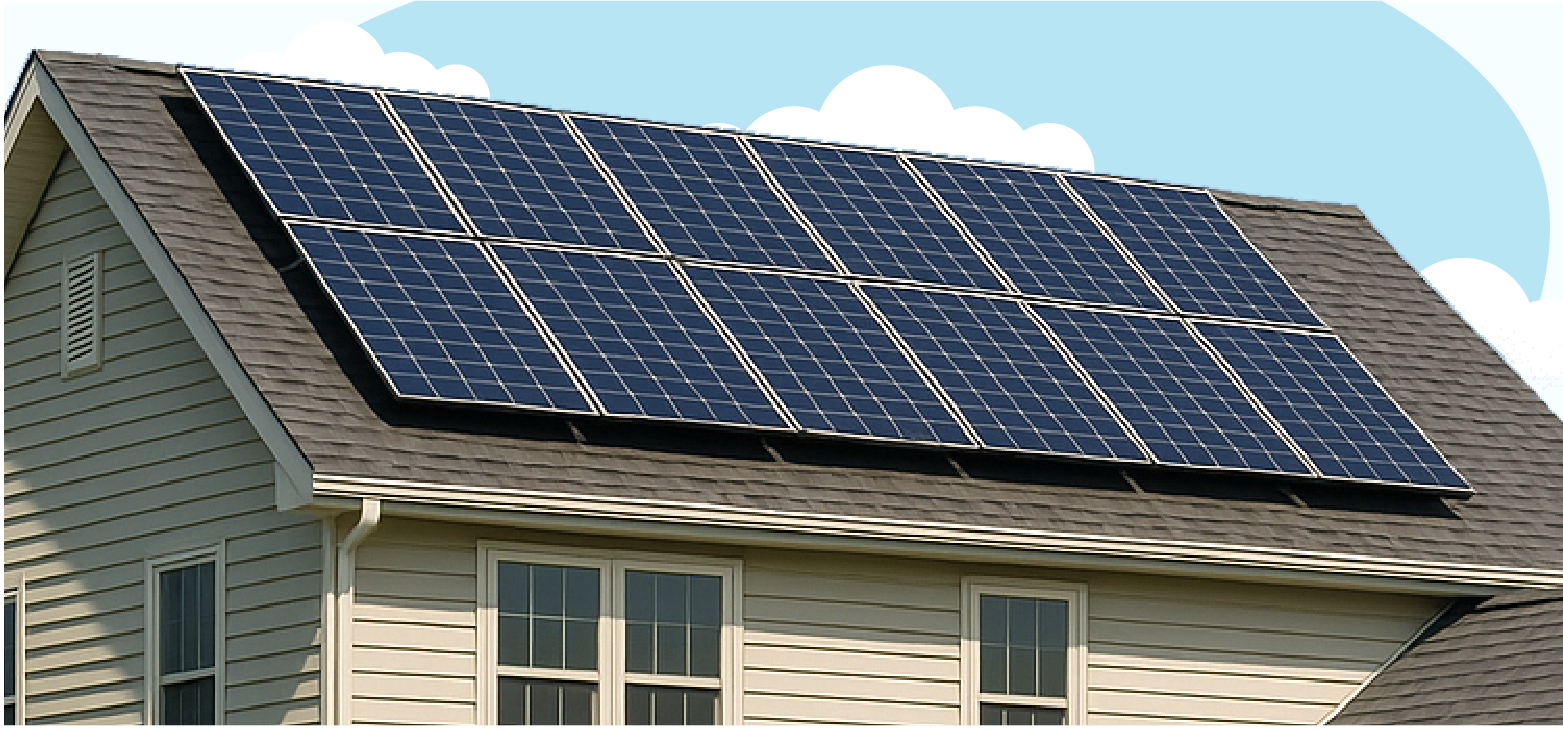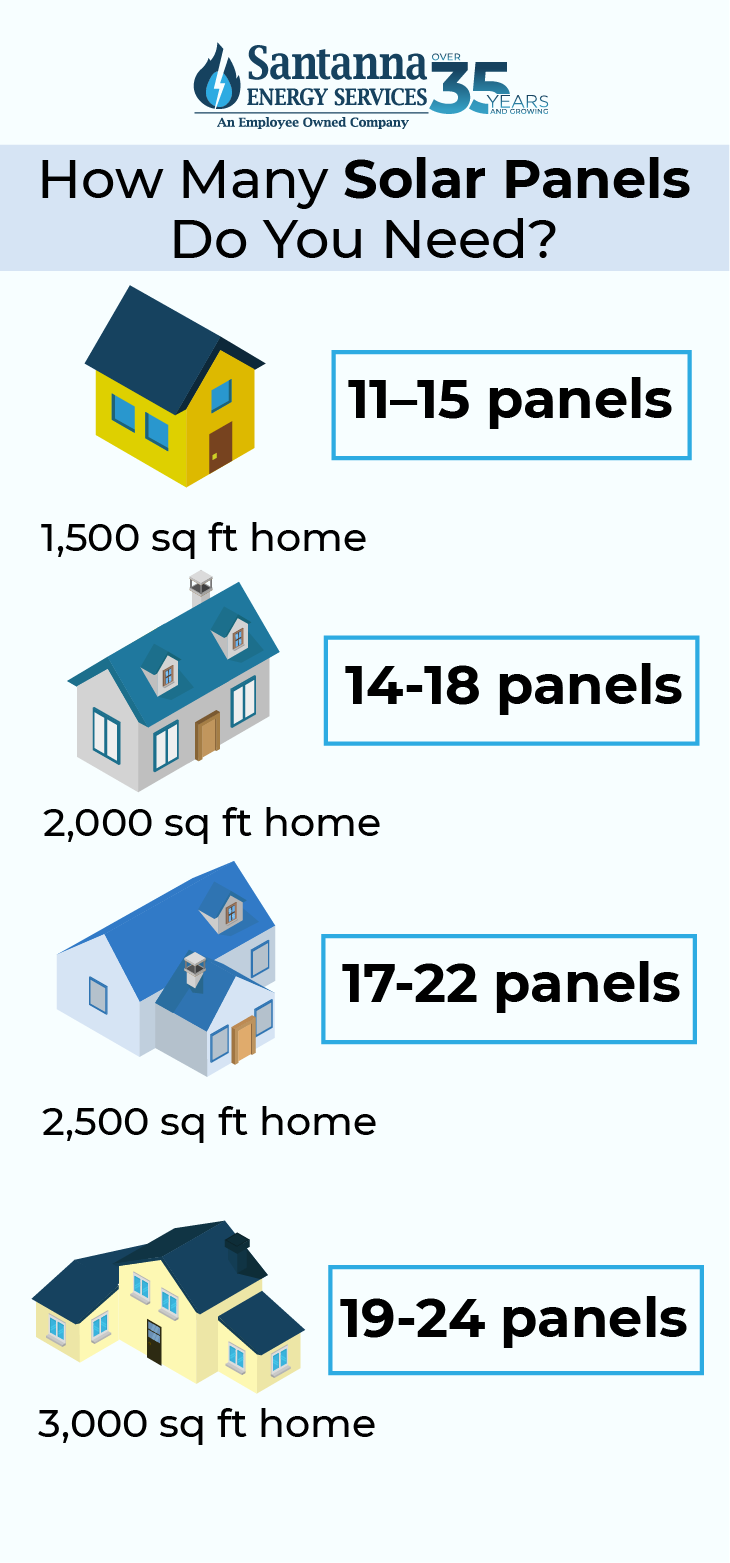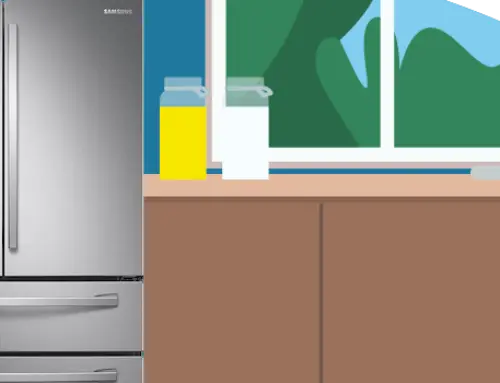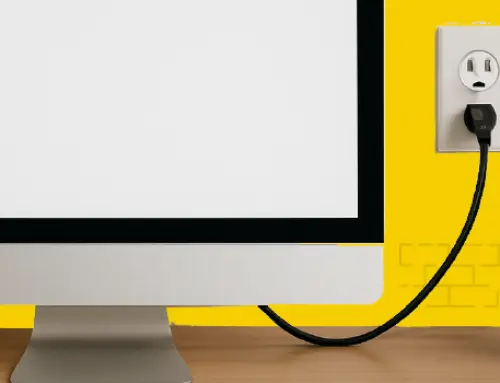How Many Solar Panels Do I Need to Power My House?
by Tyler Castle
20.3 min read

Solar energy is becoming a smart, future-focused choice for homeowners who want to reduce their electricity bills and make a real impact on the environment. With energy costs rising and climate concerns growing, more people are looking into getting solar panels and asking the same question: How many solar panels do I need to power my home?
At Santanna Energy Services, as an experienced energy supplier serving homeowners across the Midwest and beyond, we've helped thousands of customers understand their energy options and make more informed, cost-effective decisions.
The answer to how many solar panels you need isn't one-size-fits-all. It depends on your energy usage, roof space, regional sunlight, and even your long-term goals.
In this guide, we'll walk you through everything you need to know, from how solar panels work and what affects your system size, to home-specific panel estimates, state incentives, and alternatives to solar panels. Let's get started on the path to a smarter, more sustainable home.
Key Points of This Article:
- There's no one-size-fits-all answer. The number of solar panels you need depends on monthly electricity usage, your region's sunlight, roof conditions, and panel type.
- To power a home between 1,500 and 3,000 square feet, you'll typically need between 11 and 24 solar panels, depending on your energy usage and system efficiency.
- If solar installation isn't feasible, programs like Santanna's Earth-Friendly Electricity Plan let you support renewable energy without panels.
How Do Solar Panels Work?
As energy experts, we know solar panels work by turning sunlight into electricity for your home. When the sun shines on the panels, they collect the light and turn it into power using something called PV technology (short for photovoltaics).
But there’s a catch: homes can’t use that power right away. It needs to be changed into a different kind of electricity first. That’s where a machine called an inverter comes in. It switches into the power your home needs, called a direct current.
After that, the electricity goes into your home’s electric panel and powers everything from your lights and fridge to your TV and phone chargers. It all works quietly, automatically, and without using any gas, oil, or coal.
How Many Solar Panels Are Needed to Power a House?
To power a 3,000 square foot house, you’ll need roughly 25 solar panels. This is assuming you have a monthly electricity usage of 950 kilowatt-hours.
Of course, each home and situation are different and will require anywhere from 15-20 solar panels depending on your habits, home size and environment.
To figure out how many solar panels you’ll need to power your individual home, it’ll require a bit of math. To figure this out, the first thing you’ll need to know is how much electricity you use per month. As a frame of reference, in the U.S., the average household uses about 899 kilowatt-hours (kWh) of electricity per month, according to the U.S. Energy Information Administration (EIA).
Next, you’ll need to know how much energy a solar panel produces. Residential solar panels typically produce between 250 to 400 watts per hour under ideal conditions. That translates to about 1 to 2 kilowatt hours per day per panel, depending on panel efficiency, geographic location, season, and weather.
This means each panel can generate roughly 30–60 kWh per month on average, based on 4 to 5 daily peak sun hours in many U.S. regions.
So how many solar panels do you need to power a home? It depends; not just on your energy use, but on where you live, your roof setup, and your home’s efficiency. Let’s look at a few hypothetical scenarios:
How Many Solar Panels You’ll Need to Power A 2,000 Square Foot Home in Ohio
Let’s say you live in Ohio and your monthly electricity usage consistently falls around 950 kWh. You receive a modest amount of sunlight, around 4.0 peak sun hours a day, and your home is south-facing, with a 30-degree roof pitch, getting minimal shading.
Lastly, your solar panels are monocrystalline and produce 400 watts each. To figure out how many solar panels you’ll need, simply divide your average monthly usage by the estimated production ratio for your region (about 1.3 in Ohio).
- System size needed: 950 ÷ 1.3 (production ratio) =731 kW
This means you’d need a solar system capable of producing about 7.31 kilowatts. If you’re using 400-watt panels (or 0.4 kW each), you divide the system size by the panel wattage: 7.31 ÷ 0.4 = about 18.3 panels.
Since you can’t install a fraction of a panel, we recommend you round up, meaning you’ll likely need 18 to 20 panels to power a 2,000 square foot home and to meet your home’s energy needs.
How Many Solar Panels Are Needed to Power a 1,800 Sq. Ft. Home in Pennsylvania?
Let’s calculate another! Let’s say you’re thinking of powering your Pennslyvania home with solar panels and are looking to figure out how many you’ll need. At a monthly electricity consumption of 850 kWh with 4.2 peak sun hours per day, you’ll need roughly 16-18 panels to power an 1,800 square foot home.
This is assuming your monocrystalline microinverter panel system can handle up to 400 watts.
We used the same calculation as before, divide your average monthly usage by the estimated production ratio for your region (in Pennsylvania’s case, the production ratio is also 1.3); taking that estimation and dividing that by the wattage of your solar panels.
- System size needed: 850 ÷ 1.3 = 654 kW
- Panels needed: 654 ÷ 0.4 = 16–18 panels
How Many Solar Panels do I Need to Power a 2,500 Sq. Ft. Home in Illinois?
Okay, okay, last one! Assuming you live in Illinois and average a monthly electricity consumption of 1,100 kWh per hour, you’ll need quite a few solar panels to power your home. With 4.5 peak sun hours a day and using a 400-watt monocrystalline solar system, you’ll need 21-22 solar panels to power a 2,500 square foot home in Illinois.
Here’s how the calculation works out:
- System size needed: 1,100 ÷ 1.3 = 846 kW
- Panels needed: 846 ÷ 0.4 = 21–22 panels
These are just estimates, and it’s important to note that even if two homes are the same size, they may need a different number of solar panels.
That’s because energy needs depend on how much electricity you use, how much sunlight your area gets, your roof’s angle and direction, and the type of solar panels you choose. For example, if your roof is pitched and facing towards the sun with constant sunlight, you might be able to get away with less of the estimated solar panels for your home.
Square footage is just one part of the equation; it’s more important to look at your overall energy use and conditions.
How Many Solar Panels Do I Need for My Home?
We’ve found that the number of solar panels you need for your individual home depends largely on several important factors:
- How much electricity you use
- How much solar your panels produce
- How much sunlight your roof gets
- Your home’s size
- And the characteristics of your roof
Each of these elements plays a role in how much solar power your system can generate, which contributes to how many panels you’ll need for your home. Here’s more about how these factors impact your system size and can help you estimate the right number of panels for your home:
How Much Electricity You Use
Your energy usage is the foundation of your solar system. However, your exact usage will vary depending on your home size, family habits, appliances, and even if you have electric heating, air conditioning, or an EV charger.
The more electricity you use, the more solar panels you’ll need to power your home. To find your average monthly electricity usage, try looking at your most recent electricity bill!
How Much Power Your Solar Panels Produce
Not all solar panels are the same. A typical residential panel is rated between 250 to 400 watts per hour under ideal conditions, which translates to about 1 to 2 kWh per day per panel, depending on its efficiency and the amount of sunlight it receives.
If your panels don’t produce enough energy to fit your electricity demand, you risk pulling more power from the grid than expected, leading to higher utility bills and less overall savings from your solar investment.
How Much Sunlight Your Roof Gets
Solar panels work best in direct sunlight, and the more sun your roof gets, the more electricity your system can generate. This is measured in peak sun hours per day—which average 4.0–4.4 hours of sunlight a day in states like Ohio, Michigan, and Indiana; and 4.2–4.9 hours a day for states like Illinois and Pennsylvania.
Plus, the more sunlight you get, the less panels you may need for your solar system.
The Characteristics of Your Roof
Your roof’s layout, pitch, orientation, and shading all affect solar performance. Ideal conditions include:
- South-facing roof
- Tilt of 15°–40°
- Minimal shade from trees or chimneys
- Enough surface area for your system size
If your roof doesn’t meet these criteria, you might risk losing out on energy if your system isn’t strong enough. If your roof falls short, we recommend upgrading to higher-efficiency panels to ensure your roof doesn’t hinder how much electricity you charge.
So, if you’re wondering, “how many solar panels do I need for my home?” We’ve got answers. Here’s how many solar panels you’ll need for your home:
How Many Solar Panels Do I Need? Chart by Home Size and Energy Use
| Home Size | Avg Energy Consumption per Month (kWh) | # of Panels Needed |
| 1,500 sq ft | 700 | 11-15 |
| 2,000 sq ft | 950 | 14 – 18 |
| 2,500 sq ft | 1100 | 17 – 22 |
| 3,000 sq ft | 1250 | 19 -24 |
Depending on your home's size and energy use, you'll likely need between 11 and 24 solar panels to fully power a home between 1,500 and 3,000 square feet.
Note that these are rough estimates based on national averages. The actual number of panels needed can vary based on sunlight hours, roof orientation, panel wattage, efficiency, and your state's climate conditions. For example, the same home in Ohio may require more panels than one in Arizona due to less average sunlight.

How to Calculate How Many Solar Panels You'll Need for Your Home
Still unsure of how many solar panels your home needs? There's a way you can calculate an estimate yourself and it's easier than it sounds. You just need three numbers:
- Your average monthly electricity use
- How much sunlight your area gets
- The power of each solar panel. Most residential panels today are around 400 watts, which equals 0.4 kilowatts.
To estimate the number of panels you'll need, use this equation: (Monthly kWh ÷ Sunlight Factor) ÷ Panel kW.
For example, if you live in Pennsylvania, which gets about 4 peak sun hours per day (or roughly 120 sunlight hours per month), and your monthly usage is 900 kWh, the calculation would look like this: (900 ÷ 120) ÷ 0.4 = 7.5 ÷ 0.4 (this is the kilowattage of your panel) = about 19 panels.
So, you'd need around 19 solar panels to meet your monthly energy needs based on that setup.
Of course, this is just an estimate; the exact number of panels you'll need can vary based on your roof size, panel brand, seasonal changes, and future energy usage. But it's a great starting point to help you understand what your solar setup might look like.
What Is the Production Ratio in My Area?
The production ratio tells you how much electricity your solar system will generate compared to its size. It's one of the most important numbers to understand when planning a solar installation because it directly affects how many panels you'll need and how much energy you can expect to produce.
A higher production ratio means your system will generate more electricity for every kilowatt you install.
For example, if you install a 6 kW solar system in a high-sun area with a production ratio of 1.6, it could generate up to 9,600 kWh per year.
In a moderate-sun area with a production ratio of 1.3, it might generate 7,800 kWh per year. That's a big difference in output, and it can affect everything from how much of your electric bill is offset to how many panels you'll actually need.
What is the Production Ratio in the Midwest?
| State | Avg. Daily Peak Sun Hours | Production Ratio (kWh per kW per year) |
| Ohio | 4.0–4.4 hrs | ~1.3 |
| Pennsylvania | 4.0–4.9 hrs | ~1.3 |
| Illinois | 4.2–4.9 hrs | ~1.3 |
| Michigan | 4.0–4.4 hrs | ~1.3 |
| Indiana | 4.0–4.4 hrs | ~1.3 |
*Data are based on State Solar Map
If you live in Ohio, Pennsylvania, Illinois, Michigan, or Indiana, the production ratio region receives a moderate amount of sunlight at about 4 to 5 peak sun hours per day on average.
This translates to a production ratio of approximately 1.3, meaning each kilowatt of solar panels you install can generate around 1,300 kWh per year.
Are Solar Panels and Solar Energy a Good Fit for the Midwest?
The short answer is, yes, it can be!
While the Midwest may not get as much sun as the Southwest, solar is still a smart long-term investment that can significantly reduce your electricity bill and your carbon footprint.
Add in federal tax credit, net metering, and local incentives, homeowners in the Midwest have a real opportunity to benefit from going solar.
How Many Solar Panels Do You Need to Power an Appliance?
Thinking a whole solar system might be a little bit of a stretch? Why not start small with a single solar panel that can power appliances to cut down your electricity bill slowly over time.
To estimate how many solar panels it would take to power each appliance, we used the following formula:
Solar Panels Needed = Monthly Appliance Usage (kWh) ÷ 60
Why 60? We're assuming each solar panel is 400 watts, producing about 2 kWh of electricity per day, which adds up to roughly 60 kWh per month.
For example, if your air conditioner uses 24 kWh per month, you'd divide 24 by 60 and find you need about 0.4 or half a panel to power it.
If you've done your research and know that your solar panel might produce more than 400 watts, you can swap out this number to get a more accurate estimate that's closer to the output of your panel!
While solar panels don't offset appliances one by one, your system is designed to cover your total monthly usage. This breakdown helps you understand where your energy goes.
If buying a single solar panel sounds unrealistic for you, upgrading to ENERGY STAR®-certified appliances can also make a big impact by reducing your home's overall load, allowing you to do more with less.
Solar Panel Output by Appliance
Understanding how much energy your household appliances use can help you plan your solar system more effectively. The more appliances you add to your home, the more solar panels you might need to power them.
While solar panels work together to offset your total monthly electricity usage, it's helpful to see how many panels it would take to power individual items in your home.
Below is a guide showing the average energy usage of common appliances and how many 400W panels (under optimal sunlight) would be needed to cover them daily:
How Many Solar Panels I Need to Power Common Household Appliances
| Appliance | Usage Time | Average Daily Usage | Solar Panels Needed* | Average Daily Electricity Cost** @ 17.45 ¢/kWh |
| Ceiling Fan | 8 hours | 0.48 kWh | 0.01 | $ 0.08 |
| Television | 6 hours | 0.6 kWh | 0.01 | $ 0.1 |
| Microwave Oven | 0.5 hours | 0.5 kWh | 0.01 | $ 0.09 |
| Air Conditioner | 8 hours | 24 kWh | 0.4 | $ 4.19 |
| Space Heater | 8 hours | 12 kWh | 0.2 | $ 2.09 |
| Refrigerator | 24 hours | 12 kWh | 0.2 | $ 2.09 |
| Hair Dryer | 0. 5 hours | 0.5 kWh | 0.01 | $ 0.09 |
| Laptop | 10 hours | 1 kWh | 0.02 | $ 0.17 |
| Dishwasher | 2 hours | 3.6 kWh | 0.06 | $ 0.63 |
*Estimate based on 400W solar panels producing 2 kilowatt-hours (kWh) of energy per day.
** Based on the average price of electricity in the U.S., according to the EIA as of April 2025, which is 17.45¢ per kWh.
A typical household uses several high-demand appliances daily, like a refrigerator, washer and dryer, and at least one air conditioning unit in warmer months.
For example, a fridge might use around 12 kWh per month, a washer and dryer about 60 kWh combined, and an AC unit another 24 kWh. That's 96 kWh per month just for those three appliances.
If each solar panel produces about 60 kWh per month, you'd need at least 2 solar panels just to cover the electricity for your essential appliances. And that's before factoring in lights, electronics, cooking appliances, or EV chargers, showing how quickly energy use adds up and why accurate system sizing is so important.
How Do Solar Panels Work with Your Electric Bill?
Installing solar panels doesn't just give you renewable energy; it changes how you interact with your utility bill. With solar, your home pulls energy from the sun during the day, reducing the amount of electricity you need to buy from your utility.
As electricity experts, we know that in most cases, solar-generated electricity is used first. If your system produces more than you need at that moment, the extra energy is either stored in a battery (if you have one) or sent back to the utility grid.
When your panels aren't producing (like at night or on cloudy days), your home will draw power from the grid as usual.
In many states, particularly across the Midwest, net metering allows you to earn credit for the excess solar energy you don't use that your system feeds into the grid. Later, when you use grid electricity, those credits can help offset the cost, reducing what you owe on your electric bill.
Homeowners with a properly sized solar system often save over $16,587 across 20 years. You may still see small service charges for staying connected to the grid, but overall, solar makes a big difference in reducing long-term energy costs.
What Type of Solar Panels You Should Use?
There are three main types of solar panels used for residential homes. Each type has different strengths depending on your energy needs, roof space, and budget. Let's take a look at each model and break down the facts:
Monocrystalline Panels (Mono)
Monocrystalline panels are best for homes with limited roof space or high energy needs. These panels are the most efficient (up to 18-23%) and produce more electricity per square foot. Monocrystalline panels often offer a sleek black appearance and are used in high-performance systems.
Polycrystalline Panels (Poly)
Polycrystalline Panels are best for homes with larger roofs and standard energy usage. This model of solar panel is slightly less efficient (15–17%) according to EcoFlow.com, but more affordable than monocrystalline panels. These are your classic blue colored panels with a speckled texture.
You have plenty of roof space and want a lower-cost option that still performs well, the model might be right for you.
Thin-Film Panels
Thin-film solar panels are best for non-traditional installations or flexible surfaces like RVs, sheds, or flat roofs. These panels are lightweight, flexible, and easy to install, though they have the lowest efficiency (7-18%) and may degrade faster.
You need flexible placement or have special space needs this model might be right for you but this solar panel type is not ideal for most residential rooftops.
How Much Do Solar Panels Cost?
Even though solar panels power your home once they're up and running, there's still an upfront cost to install them.
According to Consumer Affairs, the average American home in 2025 typically needs a 10-kilowatt (kW) solar system that usually requires about 25 solar panels which costs about $28,241.
If this price point scares you, there are federal solar tax credits available, and you can get a big discount, typically bringing the total cost down to around $19,873 after the credit is applied. So while there's an investment at the start, the long-term savings can really add up.
Average Solar Panel System Cost by System Size
| System Size | Estimated Number of Panels | Before Federal Tax Credit | After Federal Tax Credit |
| 5 kW | 12 | $14,210 | $9,937 |
| 6 kW | 15 | $17,034 | $11,924 |
| 7 kW | 17 | $19,873 | $13,911 |
| 8 kW | 20 | $22,712 | $15,898 |
| 9 kW | 22 | $25,551 | $17,886 |
| 10 kW | 25 | $28,241 | $19,873 |
*Data from Consumer Affairs
If you're planning a small DIY solar setup and only need a few panels, you can expect to spend about $200 to $350 per panel, which comes out to roughly $0.80 to $1.40 per watt, depending on the brand and efficiency.
While going the DIY route can save money, safety should always come first. If you're unsure about the installation or electrical work, it's best to contact a licensed solar professional.
Local Incentives & Rebates in PA, OH, IL & MI
Homeowners across Pennsylvania, Ohio, Illinois, and Michigan can all take advantage of the 30% Federal Solar Investment Tax Credit (ITC), which significantly lowers the upfront cost of going solar.
All four states also offer net metering through select utility providers, allowing you to earn bill credits for excess electricity your solar panels send back to the grid, helping lower your bill even more.
Many homeowners in these states can also earn Solar Renewable Energy Certificates (SRECs), with one SREC awarded for every 1,000 kWh your system generates; these can often be sold for additional income. Illinois stands out with its Adjustable Block Program (Illinois Shines), offering upfront or performance-based payments for residential solar.
Meanwhile, Pennsylvania and Ohio provide sales and property tax exemptions, and Michigan utilities like DTE and Consumers Energy occasionally offer pilot rebates or performance-based credits.
While each state varies slightly, the combination of federal incentives, net metering, and local programs makes solar more affordable and rewarding in all four.
Alternatives to Solar Panels and Solar Energy
Does getting a solar system sound out of reach for you? No worries because going solar isn't the only way to support clean, renewable energy.
While solar panels can be a great option for some homeowners, they aren't right for everyone. There are still a few great alternatives. That's where Santanna's Earth-Friendly Electricity Plan comes in.
With our Earth-Friendly plan, you don't need to install solar panels to make a difference. Instead, you can enroll in an energy plan that matches your electricity usage with Renewable Energy Credits all while supporting clean sources like wind and solar.
So, whether you're not ready for solar—or simply prefer a simpler, low-commitment option—Santanna's Earth-Friendly Plan is a smart way to power your home with purpose.
FAQs
Do Solar Panels Need Direct Sunlight?
Solar panels definitely work best when they're soaking up direct sunlight, but they don't stop working if the sun isn't shining directly on them. They can still generate electricity from indirect sunlight, like on cloudy days or when light is bouncing off surfaces.
What Are Peak Sunlight Hours?
Peak sunlight hours refer to the number of hours per day when sunlight intensity reaches 1,000 watts per square meter—strong enough for solar panels to produce their rated output. Most U.S. homes get 3 to 5 peak sun hours per day, depending on location.
Do Solar Panels Work at Night?
No, solar panels don't produce electricity at night since they need sunlight to generate power. However, your home can stay powered by using energy stored in a battery (if you have one) or by drawing electricity from the utility grid.
Can Solar Panels Power Your Whole House?
Yes, solar panels can absolutely power your entire home, as long as your system is properly sized to meet your electricity needs. With the right system size, good sun exposure, and access to net metering or battery storage, your solar setup can generate all the electricity you need throughout the year.
How Many Solar Panels Do You Need to Charge a Tesla?
To charge a Tesla Model 3 long-range daily, you'll need about 6 solar panels rated at 400 watts each. This estimate assumes around 5 hours of sunlight per day and accounts for energy loss during conversion. Actual needs may vary based on location, driving habits, and panel efficiency.
How Long Do Solar Panels Last?
Most solar panels last 25 to 30 years or more. While their energy production gradually declines over time (about 0.5% efficiency loss per year), high-quality panels still operate at 80–90% capacity after 25 years.
Do Solar Panels Affect Home Insurance?
Yes, but usually in a positive way. Most insurers cover rooftop solar panels under your existing dwelling coverage, though you should notify them after installation. Some policies may increase slightly due to the added home value. Always check with your provider.
How Many Solar Panels Do I Need to Go Off-Grid?
To go off-grid, most homes need a system that can produce at least 100% of their daily energy needs, plus battery storage for nights and cloudy days. A typical off-grid home may require 25–40+ panels, depending on energy use, location, and sun exposure.
Tyler is an experienced energy professional, having worked for Santanna Energy Services, for the past four years. He is passionate about renewable energy and believes that diversifying the energy grid is the key to a sustainable future. Tyler is dedicated to supplying consumers with the best possible energy solutions and works diligently to make sure that Santanna can deliver the highest quality service.







